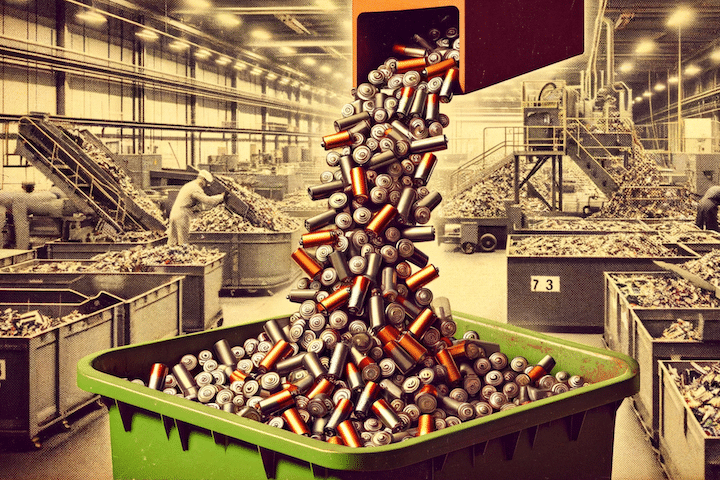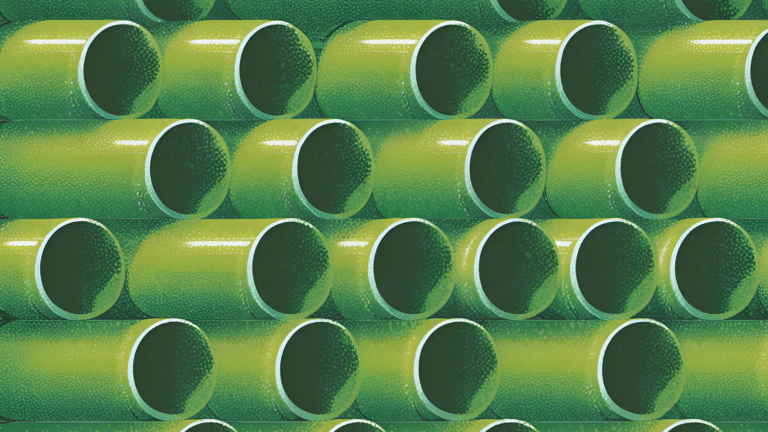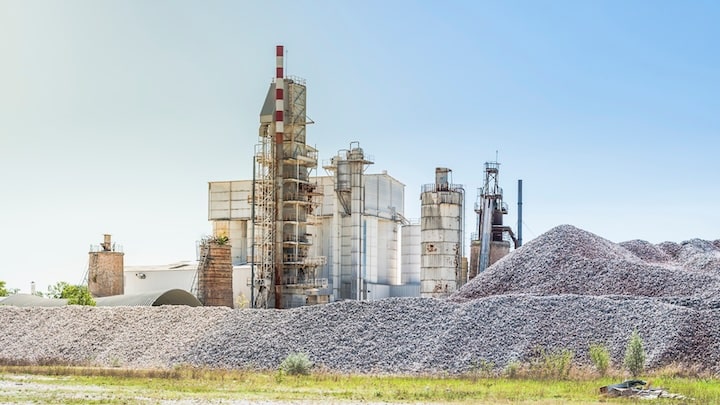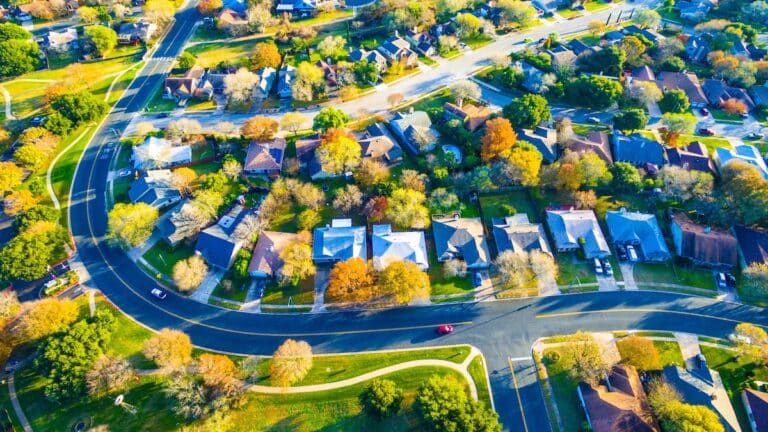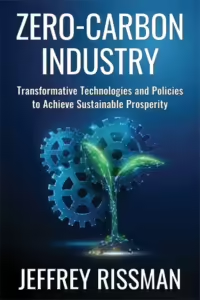Melissa Lott: [00:00:00] Like it or not, February is all about hearts and romance. So today on the show, we’re going to bring you a love story. [00:00:06][6.7]
Rebecca Dao: [00:00:10] Yeah. When you when you kind of strip it down to its essentials, concrete is amazing. [00:00:15][4.7]
Melissa Lott: [00:00:16] Okay. So it’s not your usual romantic storyline, but this is definitely a love story between humans and this really goopy gray soup that’s made up of sand and stone and water and cement. [00:00:27][10.4]
Rebecca Dao: [00:00:27] Here’s a completely insane fact. So we make 4 billion tons a year of cement, which translates into about 30 billion tons a year of concrete. So that’s almost £10,000 of concrete being poured every year for every human being on the planet. You, your brother, your grandma, your grandchild, everybody. [00:00:52][24.8]
Melissa Lott: [00:00:53] We’re obsessed with the stuff and for a good reason. [00:00:56][2.3]
Rebecca Dao: [00:00:57] It’s a rock that you can pour. You can put it in a truck. You can pump it through a pipe. You can pour it into a mold. You can get any shape that you want out of it because you can handle it like a liquid. But then it dries into Iraq. And so that makes it an incredibly valuable material for building almost any kind of structure. [00:01:18][21.4]
Melissa Lott: [00:01:24] But see, there’s a problem. This love affair, it’s currently a toxic relationship. The way that we make and use concrete, especially the cement, the bit, the glues, it all together. It generates more carbon pollution than any country in the world except the US and China. So what are we going to do about this toxic relationship? Are we going to cut ties or do we try to fix it? This is the big switch. A show about how to rebuild the energy systems that are all around us. To slow climate change, we need to transform our buildings, homes, cars and the economy as quickly as possible. But how do we do it right? I’m Dr. Melissa Lott, and I’m the director of research at Columbia University’s Center on Global Energy Policy. And I study the technologies and systems that power our world. So today we’re talking about concrete and all the emissions that come from the industries that are behind it. So we figured what better place to start than one of the places that makes it. [00:02:31][66.3]
Speaker 3: [00:02:32] And if you’ve never been to a concrete plant, the first thing you probably noticed is this loud. [00:02:36][4.2]
Melissa Lott: [00:02:37] It isn’t the most glamorous thing in the world. [00:02:39][2.0]
Daniel Waldorf: [00:02:40] Getting stuck in the mud here. I should have brought some better boots. [00:02:44][3.6]
Melissa Lott: [00:02:45] That’s our producer, Daniel Waldorf. We sent him to a plant run by Thomas Concrete in North Carolina. [00:02:50][4.5]
Daniel Waldorf: [00:02:51] Can you just tell me what your name is and what you do here? [00:02:53][2.0]
Tyler Krantz: [00:02:53] Yes. I’m Tyler Krantz. I’m the technical services manager for Thomas Concrete here in Raleigh, North Carolina. [00:02:59][6.1]
Melissa Lott: [00:03:00] Tyler says that most of us just don’t give concrete a second thought. [00:03:03][2.8]
Tyler Krantz: [00:03:04] You see the hardened product at the end and you drive on it. You walk on it, but you probably don’t you know, you don’t think about what goes into making that. [00:03:13][8.5]
Melissa Lott: [00:03:13] If we want to understand where carbon emissions are coming from in this industry, we first need to step back and go through some basics like what is concrete and how is it different from cement? [00:03:22][9.0]
Rebecca Dao: [00:03:23] Yeah, so concrete is mostly what you observe out in the world, in foundations, in tall buildings and not so tall buildings. And cement is the most important ingredient in concrete. [00:03:36][12.8]
Melissa Lott: [00:03:40] That’s Dr. Rebecca dao. She works at an organization that’s called the ClimateWorks Foundation, and she works on the different ways that we can remove carbon pollution from industries like concrete, steel and chemicals. [00:03:50][10.2]
Rebecca Dao: [00:03:51] Basically, concrete is you can think of it like a Rice Krispie treat. So a Rice Krispie treat. You’ve got your Rice Krispies and they’re being glued together by your marshmallows with concrete. You’ve got sand and rocks and they’re being glued together by cement. [00:04:11][19.3]
Melissa Lott: [00:04:11] So if we love concrete so much, what’s the problem? And what as we go to net zero, what’s the challenge when it comes when it comes to concrete in cement? [00:04:19][7.7]
Rebecca Dao: [00:04:20] Making concrete in cement generates a huge amount of carbon pollution. And it’s not that making cement and concrete is somehow particularly greenhouse gas intensive. It’s not that making £1 of cement generates more CO2 than making £1 of another material on that kind of intensity scale. Cement and concrete are actually pretty climate friendly. The problem is that we use so much of them. And so even though each individual pound of cement might not have made a lot of CO2, when we’re talking about £10,000 of concrete per person, that adds up really fast. [00:05:01][40.7]
Melissa Lott: [00:05:10] Where are we actually producing emissions? Is it at the house when I’m building the foundation? Is it somewhere before then? Where does it come from? [00:05:16][6.8]
Rebecca Dao: [00:05:17] Yeah. So the thing that’s really responsible for most of the greenhouse gas emissions is the cement, which is to say the glue that holds it all together. [00:05:25][8.0]
Melissa Lott: [00:05:26] Right. So that’s exactly what Tyler at Thomas Concrete told our producer, Daniel during his tour of the plant. [00:05:31][5.2]
Tyler Krantz: [00:05:32] Hands down, the production of Portland Cement is the biggest contributor to the greenhouse gas. Just the process of digging the material out of the ground. The the the kilns that they use 1400, 1700 degrees burning nonstop. [00:05:50][17.9]
Rebecca Dao: [00:05:52] In order to make cement. You have to get it really, really hot. So the core part of this process is you start with rocks, you start with limestone, which is one of the most common types of rocks in the world, and you heat it up to more than a thousand degrees Celsius. So you actually heat it up to about 2600 degrees Fahrenheit. [00:06:12][20.9]
Melissa Lott: [00:06:13] That’s a lot. [00:06:14][0.2]
Rebecca Dao: [00:06:15] Yeah, it’s very hot. And when you do that, it undergoes a chemical reaction which transforms it from limestone into cement in order to get it that hot. We burn stuff, usually coal, sometimes other stuff, But burning all that stuff to make all of that heat emits a lot of greenhouse gases. But then even more than that, the key part of that transformation from limestone into cement is that there’s actually CO2 that’s trapped in the limestone that gets emitted back out into the atmosphere. And so we’ve got CO2 both coming from the fuel that we’re burning, but also coming straight out of the rocks. [00:06:57][42.7]
Melissa Lott: [00:06:58] So as we move to net zero, what are the biggest levers, the biggest buckets of tools that we have to get us to net zero? [00:07:05][7.0]
Rebecca Dao: [00:07:06] I think that we can kind of split our buckets into overarching categories. So bucket one is can we use less cement and concrete? Bucket two is can we reduce the greenhouse gas emissions for the cement and concrete that we do use on the use less side? We absolutely can use less. And in fact, we tend to be quite wasteful in the way that we use these materials because they’re pretty cheap. So a number of of engineers have done studies of buildings in the United States and in Europe, and they have estimated that you could reduce the amount of structural material, which is mostly concrete and also sometimes steel and other things as well. But you could reduce the amount of structural material in these buildings by between 30 and 50%. So up to cutting the amount of material in half and still be in full compliance with the various safety protective building codes that these buildings are operating under. So we could really reduce substantially the amount of concrete that we’re using without posing any safety risks at all. [00:08:23][77.0]
Melissa Lott: [00:08:24] So this is option one. We use less concrete overall, but we still have to use some concrete. And right now, we just don’t have a great zero carbon alternative to allow us to completely swap it out and eliminate all that pollution. But we have some ways to make concrete with less carbon pollution. And it turns out that there are a lot of opportunities to get the same quality of concrete with a smaller amount of cement. [00:08:45][20.8]
Rebecca Dao: [00:08:46] So you can glue your rocks together just as strongly, but with less glue if you do it carefully. And so both of those things are going to help us really reduce the total amount of greenhouse gases from the system. [00:08:58][12.1]
Melissa Lott: [00:08:59] Going back to the Rice Krispie metaphor, what Rebecca is saying is that we can have the same great Rice Krispie treat, same great taste, same great structural integrity with a lot less marshmallow binding it all together. And some concrete companies like the one we visited at the top of the show, they’re trying to use a lot less cement. That’s a lot fewer marshmallows to make their concrete. [00:09:17][18.9]
Tyler Krantz: [00:09:18] We don’t want to waste money. We don’t want to put extra cement, and that doesn’t need to be in. [00:09:23][4.7]
Melissa Lott: [00:09:24] So how exactly do we use less? Tyler Krantz at Thomas Concrete says that you can add materials to reduce the amount of cement. And one common material that you can add is called fly ash. It’s actually a waste from coal fired power plants. We’ve burned a lot of coal over the years, and so there’s a lot of fly ash just sitting around in pits today. But coal power plants are shutting down and we’re burning less and less coal. So in the long term, there’s a problem. [00:09:49][25.3]
Tyler Krantz: [00:09:50] Less and less coal plants, less and less fly ash. So it will be something that will have to be looked at down the road. [00:09:56][6.1]
Melissa Lott: [00:09:57] Another thing that you can add to concrete to reduce the amount of cement that’s needed is a little bit surprising. You can actually add carbon dioxide directly to the concrete mix, which in itself does two things. It increases the strength of the concrete. So you don’t need as much when you’re building something. And it also locks carbon dioxide away in the rock so that it can’t heat up the atmosphere. The technology is sold by a company called Carbon Cure. It sounds a bit like crazy science, but Tyler says it’s actually not that exciting. [00:10:24][26.6]
Tyler Krantz: [00:10:25] Garbage. Your process is very boring. Really. There’s a nozzle there. I’m not sure exactly where it’s located, but when he presses that button, it should look almost like a puff of vapor to see if we can see it as he saw that it was just like a set. That’s it. It’s just like a flash of light. That’s it. [00:10:49][23.6]
Melissa Lott: [00:10:50] That simple puff of vapor. It makes the concrete stronger and it keeps CO2 out of the atmosphere. And so adding things to the concrete to make cement go further, well, that’s option number two. And it seems simple enough, but changing the composition of something that literally holds up the buildings that we’re living in and working in the bridges that we drive over, it makes some people nervous. And when Tyler talks with others in the construction industry, he often hear some hesitation. [00:11:17][26.3]
Tyler Krantz: [00:11:18] I’ve been doing this for years. This is the way it’s been for years. And I think in general, people are kind of not open to change, you know, just just as something that’s always been done this way. Right. So. So, you know, it’s I think, more of a you have to prove that it works. [00:11:37][19.3]
Rebecca Dao: [00:11:38] Some alternative cements are really exciting, but people are very cautious about whether they want to use them because we’re we’re literally talking about foundations here. If you make a concrete foundation and you build a building on top of it, you want to feel confident that that building is going to be around and going to be strong and stand up for a long time. And if you have a new material, you might not have that same confidence in how it’s going to perform ten, 20, 50, 75 years in the future. So alternative cement chemistries are really interesting, but they’re probably going to come into the market pretty slowly because people are going to approach them cautiously. [00:12:22][43.7]
Melissa Lott: [00:12:26] So all companies like Thomas Concrete are working to prove that lower carbon concrete is a viable product for their consumers. We have to think about what to do with the CO2 that we can’t eliminate from this naturally carbon intensive process. [00:12:38][12.1]
Rebecca Dao: [00:12:39] Another option that we have is that we can capture the CO2 that is coming out of these rocks and we can put it back underground. Instead of releasing it into the atmosphere, we can store it, which is called This is carbon capture and Storage. [00:12:54][15.4]
Melissa Lott: [00:12:55] This is option number three. Carbon capture and storage, which we also call CCS. It means that we find a concentrated source of CO2 emissions like a smokestack, and then we use machinery to remove that carbon dioxide, and then we find a way to store it often underground. And this is the solution that people are talking about across different parts of the economy, not just an industry. [00:13:15][20.0]
Rebecca Dao: [00:13:16] In my opinion, even if we decide that we don’t want to use CCS in any other part of our economy, the one place where we’re most likely going to need to use carbon capture and storage for at least a significant part of the solution is going to be in the cement industry. And it just comes back to the fact that the CO2 comes straight out of the rocks. [00:13:39][22.6]
Melissa Lott: [00:13:40] So we’ve talked about these three tools for reducing carbon emissions with concrete, but consumers have one more tool, and it’s a big one, which means we need to understand who’s buying all this concrete. [00:13:50][10.2]
Rebecca Dao: [00:13:51] So almost everywhere, the single largest purchaser of concrete is your local government Department of Transportation. Roads require a lot of concrete and they build the roads. So when we’re thinking about solutions, one of the first solutions that we go to is, Hey, you’re using our tax dollars to buy that concrete. You have so much power over the concrete market because you’re the single biggest customer. So can we get our governments to buy lower greenhouse gas concrete? [00:14:25][33.9]
Melissa Lott: [00:14:26] Are there policies out there right now in different parts of the world that actually do require lower carbon concrete and our governments thinking about adopting more of them? Is this something that’s on the table right now and being discussed. [00:14:39][13.0]
Rebecca Dao: [00:14:40] Here in the United States? It’s about 45% of all cement is purchased with taxpayer dollars. There’s a lot of interest in using the government’s buying power to move toward lower carbon, cement and concrete, but we’re at a pretty early stage in that work. So just in the last year, the state of Colorado and the state of New York have passed laws to try and do this. And just two months ago, President Biden issued an executive order instructing the federal government to start a process to do this. But none of those policies are implemented and, you know, being enforced out in the economy yet because they’ve just passed within the last year and they don’t, you know, take some time to go from saying you’re going to do the policy to actually having it enforced. [00:15:42][62.1]
Melissa Lott: [00:15:43] So you talk about how cheap concrete is today, concrete and cement are today. When I look at a net zero world and concrete and cement. Is it a lot more expensive? What are we talking about here? [00:15:55][11.9]
Rebecca Dao: [00:15:55] Yeah, that’s a great question. And honestly, probably climate safe, cement and concrete is going to be a little bit more expensive than what we pay for cement and concrete today. But actually, very few people buy cement and concrete. The thing you want is not the concrete, it’s the building. And so when you look at it from the perspective of the building, that difference in price makes no difference at all. So today in the United States for building construction, less than 0.5% of the cost of the building is the cement. So even if your cement gets a little bit more expensive, you’re literally not going to notice that compared to the cost of the building, this is going to be very affordable, even if we have to make some investments to make it happen. [00:16:50][54.7]
Melissa Lott: [00:16:51] Do we have all the tools we need, all the technology we need to actually do everything that you’re describing in that roadmap, or do we still need to figure a few things out? [00:17:00][8.8]
Rebecca Dao: [00:17:04] Even though we haven’t made a lot of progress on cement and concrete decarbonization so far, that’s not because we don’t have tools. There are fully mature technologies that are in wide use around the world that we could be implementing here in the United States tomorrow that would reduce our emissions from this sector probably by 30%. So there’s 30% emissions that are just on the table. We could do it tomorrow. None of them would even be particularly expensive. In fact, some of them would be cost savings. [00:17:37][33.5]
Melissa Lott: [00:17:42] Let’s recap. In the Rice Krispie treat, the marshmallow is the cement, and it’s the glue that holds all that puffed rice together. And in the concrete, the cement is where most of the carbon pollution comes from. So if we want to decarbonize this whole industry, what are our options? Number one, we can use less concrete. And like Rebecca said, in many cases we could be using substantially less concrete and still have the same structural integrity. But number two, we can use less cement in concrete by using additives like fly ash and carbon dioxide to make the cement go further. Number three, we could capture the carbon coming out from these big super high temperature kilns that make the cement. And number four, we can use the buying power of governments to drive demand for low carbon concrete. And the good news is that we can actually do all this stuff. So why aren’t we? Well, people are nervous about changing something that has worked so well for so long, something that’s literally holding up our buildings. And also, if we go back to our love story, relationships are hard. We’ve been using concrete and cement the same way for literally centuries. We’re settled in and it’s going to take us time to change. [00:18:50][68.9]
Rebecca Dao: [00:18:51] And so, you know, while getting to zero in the cement and concrete sector is going to be hard, getting started is not. We could start tomorrow. [00:19:01][9.5]
Melissa Lott: [00:19:05] And a few companies like Thomas Concrete are taking the first few steps right now. [00:19:08][3.7]
Tyler Krantz: [00:19:09] It seems like baby steps, but I feel like if you don’t take those baby steps, then nothing gets done, right. [00:19:15][5.9]
Melissa Lott: [00:19:18] And that’s our show. Next up on the big switch Chemicals. The big switch is produced by Columbia University’s Center on Global Energy Policy in partnership with Post-Script Media. This episode was produced by Danielle Waldorf in Alexandria. Her story editing by Ann Bailey. Theme Music, Mixing and Scoring by Sean Marquand. And a special thanks to our Columbia team Kirstin Smith, Kewley, Liz Smith. And now we’ve got our executive editor, Steven Lacy. I’m Dr. Melissa Lott. And this is the big switch. [00:19:18][0.0]
[1069.7]



